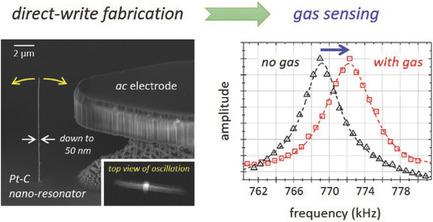当前位置:
X-MOL 学术
›
Adv. Funct. Mater.
›
论文详情
Our official English website, www.x-mol.net, welcomes your feedback! (Note: you will need to create a separate account there.)
Tunable 3D Nanoresonators for Gas‐Sensing Applications
Advanced Functional Materials ( IF 19.0 ) Pub Date : 2018-03-15 , DOI: 10.1002/adfm.201707387 Georg Arnold 1 , Robert Winkler 1 , Martin Stermitz 1 , Angelina Orthacker 1 , Joo‐Hyon Noh 2, 3 , Jason D. Fowlkes 2, 3 , Gerald Kothleitner 1, 4 , Michael Huth 5 , Philip D. Rack 2, 3 , Harald Plank 1, 4
Advanced Functional Materials ( IF 19.0 ) Pub Date : 2018-03-15 , DOI: 10.1002/adfm.201707387 Georg Arnold 1 , Robert Winkler 1 , Martin Stermitz 1 , Angelina Orthacker 1 , Joo‐Hyon Noh 2, 3 , Jason D. Fowlkes 2, 3 , Gerald Kothleitner 1, 4 , Michael Huth 5 , Philip D. Rack 2, 3 , Harald Plank 1, 4
Affiliation

|
The detection of gas species with high sensitivity is a significant task for fundamental sciences as well as for industrial applications. Similarly, the ongoing trend for device miniaturization brings new challenges for advanced fabrication including on‐demand functionality tuning. Following this motivation, here the additive, direct‐write fabrication of freestanding 3D nanoarchitectures is introduced, which can be brought into mechanical resonance via electric AC fields. Specifically, this study focuses on the 3D nanostructure synthesis, the subsequent determination of Young's modulus, and demonstrates a postgrowth procedure, which can precisely tune the material modulus. As‐fabricated resonators reveal a Young's modulus of 9–13 GPa, which can be increased by a factor greater than 5. Next, the electric readout of the resonance behavior is demonstrated via electric current measurement as an essential element for the resonance sensor applications. Finally, the implications of gas‐physisorption and gas‐chemisorption on the resonance frequencies are studied, representing a proof‐of‐principle for sensing applications by the here presented approach.
中文翻译:

适用于气体传感应用的可调谐3D纳米谐振器
对于基础科学以及工业应用而言,高灵敏度的气体种类检测是一项重要的任务。同样,设备小型化的趋势为高级制造带来了新挑战,包括按需功能调整。遵循这种动机,这里介绍了独立式3D纳米结构的累加,直接写入制造,可以通过交流电场将其引入机械共振。具体来说,这项研究集中在3D纳米结构的合成,杨氏模量的后续确定上,并演示了可以精确调整材料模量的后生长过程。制成的谐振器的杨氏模量为9-13 GPa,可以增加大于5的倍数。接下来,谐振行为的电读数通过电流测量得到证明,这是谐振传感器应用中必不可少的元素。最后,研究了气体物理吸附和气体化学吸附对共振频率的影响,代表了本文提出的传感应用的原理证明。
更新日期:2018-03-15
中文翻译:

适用于气体传感应用的可调谐3D纳米谐振器
对于基础科学以及工业应用而言,高灵敏度的气体种类检测是一项重要的任务。同样,设备小型化的趋势为高级制造带来了新挑战,包括按需功能调整。遵循这种动机,这里介绍了独立式3D纳米结构的累加,直接写入制造,可以通过交流电场将其引入机械共振。具体来说,这项研究集中在3D纳米结构的合成,杨氏模量的后续确定上,并演示了可以精确调整材料模量的后生长过程。制成的谐振器的杨氏模量为9-13 GPa,可以增加大于5的倍数。接下来,谐振行为的电读数通过电流测量得到证明,这是谐振传感器应用中必不可少的元素。最后,研究了气体物理吸附和气体化学吸附对共振频率的影响,代表了本文提出的传感应用的原理证明。



























 京公网安备 11010802027423号
京公网安备 11010802027423号